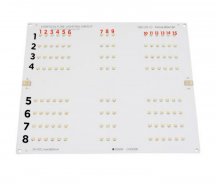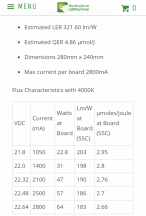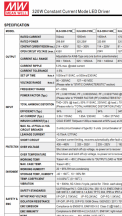TerpyTyrone
LED Recruiter
If I had the $$$$ I would experiment!!
Sure.I would propose some experimentation. My hypothesis is that you will not be able to measure any difference.
Mid power LED is the most effecient lighting tech. Meaning it will produce the least amount of initial heat per wall watt used.I know if I'm running an led @ max current, its gonna be hot.
But your scenario of heat exchange and proportions theoretically sound correct but I'm not the one playing devils advocate. That would be one hell of a comparison.
Even if it was comparatively "powered" lights.
Say 3500k 600 watts @ 75% of max current amd see what is the most efficient based on heat and par output.
Cobs, strips, boards, etc
Well said sir!Mid power LED is the most effecient lighting tech. Meaning it will produce the least amount of initial heat per wall watt used.
What's going to effect ambient temps is the temperature of the tech inside the tent. The effeciency of the tech effects how hot it gets. The more energy used to make light the less energy wasted as heat. The less intial heat made will make the air cooler.
Then there's levels of effeciencies within the tech. LED can have varying effeciency with the same μmol/j output if the SPDs are different. Ie 2 LED can both be rated 2.2μmol/j but 1 can run hotter being driven by the same wattage and outputting the same photon count because certain WV are lower energy than others, or require less power to create than other WV.
That was a lot of flagellation to compare a space heater to an LED, eh? I get what you're saying, but the differences here are much smaller. I am interested in comparing 4 strips vs. 8, 4 boards vs. 8.Sure.
I've seemed to notice posts about temps being reduced when doubling board realestate but a true expirement would be good.
Let's use a (5) × 5gal DWC in a 4x4 for thought expirement purposes (and random musings) in the meantime lol. Assuming water level in each at 3gal.
3gal × 5 × 3.79kg/gal
=
56.85kg of water not counting plant weight.
Tent might weigh 10kg. The air is ~3.85kg. So the water seems by far the majority composition of the system. Imagining a closed system within the bounds of the tent, lets say a duration of 24hrs passes after the energy from 600w of lights being run for 12hrs (7.2kWh) is pumped into the tent (closed system) vs 7.2kWh used to power a space heater in a tent. Regardless of whether a space heater was used or an LED light were used, 7.2kWh will finally be distributed evenly throughout the system with the majority being absorbed and stored in the water. But 1 will achieve equilibrium earlier than the other, or 1 will transfer the total energy to the water faster (due to the different forms of energy transfer being utilized).
The Cp of water is ~76 the Cp of air is ~1. This means that even if the ratio of mass were equal in the closed system between air and water, the energy would be more concentrated in the water. Because heat travels from hot to cold, if the same amount of energy were applied to equal masses of air and water, the air would heat up 76× more and transfer to the water to equalize the gradient.
In the tent that we're assuming is a closed system the proportion of air is not equal, it's ~14.7× less prevalent than the water, ontop of the Cp being ~76× less. Pretty much all energy input to the system will be absorbed by the water, but at what rate?
Using air to transfer the energy is much slower than using light. Visible light isn't absorbed by air. Light is instaneously distributed throughout the physical exteriors of the system with which it reacts with. So the instaneous ambient is effected almost soley by the % of power being converted directly to thermal, or the portion of the tech that is acting like a space heater.
If you have a smaller space heater in a room vs a bigger space heater, 1 will heat the air quicker. A space heater transfers its energy to the air more effecient than a light bulb. It's why we use space heaters instead of fluorescent lights.
I'm not sure exactly what the rate of change would be, but thermodynamically speaking 1 will raise ambient quicker than the other. When you throw exhaust rates in the calculation you effectively increase your air mass and volume and circulation rates, and I think a small % of effeciency increase can be noticed pretty drastically when it comes to ambient.
Imagining what (8) QBs run at 600w compared to a 600w HPS would look like. Seems most have to extract the air much more with HPS vs LED, I think most HPS are close to ~45% effeciency, and LED is closer to ~60% effeciency when driven soft. Only ~15% difference but pretty drastic ambient temp differences.
My hypothesis is ~"more than expected," yours seems ~"less than expected," though I think we both agree that thermodynamically there is a difference in transfer rates and methods, which directly relate to subsequent ambient temps. I don't know for certain and would applaud an expirement. Perhaps I'm not correct, and it's not as noticeable as I think. I think I was wrong once if I try to remember back that long ago haha lol jks I'm often wrong but I think I'm modeling this scenario correctly
EDIT:
A 5% effeciency difference using 600w is ~1.8kJ/min delta being added to the air. It only takes ~3.85kJ to raise ambient 1°C. If the system is closed then that's 1°C delta every ~2min.
600w × 5% = 30w ; 30J/s
30J/s × 60s/min = 1,800J/min ; 1.8kJ/min
Cp of air = 1kJ/kg·K°
Mass of tent air = 3.85kg
(3.85kJ/K°) / 1.8kJ/min
=
2.13min/K° of tent air
That was a lot of flagellation to compare a space heater to an LED, eh? I get what you're saying, but the differences here are much smaller. I am interested in comparing 4 strips vs. 8, 4 boards vs. 8.
I think most HPS are close to ~45% effeciency, and LED is closer to ~60% effeciency when driven soft. Only ~15% difference but pretty drastic ambient temp differences.
Ya a space heater is the same thing as the non light producing part of the LED set-up. That's why I'm using that as an example. They meaure the incredible effeciency of LED with pulsed currents and @65mA per chip (most times). As soon as you turn the juice up they drop pretty considerably in effeciency. The question is how much. If there's at least a 5% effeciency difference between double or halved board realestate then I think you'll notice the ambient temps to be significantly different with time, maybe 1-2 degrees C° would be a guesstimate.EDIT:
A 5% effeciency difference using 600w is ~1.8kJ/min delta being added to the air. It only takes ~3.85kJ to raise ambient 1°C. If the system is closed then that's 1°C delta every ~2min.
600w × 5% = 30w ; 30J/s
30J/s × 60s/min = 1,800J/min ; 1.8kJ/min
Cp of air = 1kJ/kg·K°
Mass of tent air = 3.85kg
(3.85kJ/K°) / 1.8kJ/min
=
2.13min/K° of tent air
It can give an idea.@ChiefRunningPhist
A long standing statement that has been regurgitated 100s of times over on RIU is that 600w of any light will create the same heat. Because 1watt is 3.41btu/h
With a simple answer are you saying this is correct or incorrect?
Right on.It's correct in a closed system, but bottom line is there may be some differences once you factor in heat loss, rates of heating, etc.
I have been creeping the farm! I knew I had the real deal gear!!That’s spot on. I’m running 660w in a 5x5 and am getting killer results. This is an UZi Cookies almost ready to chop. The nugs are really dense and chunky.
View attachment 7224View attachment 7225
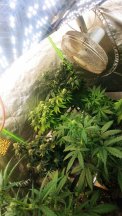
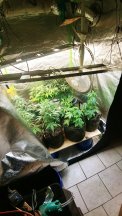
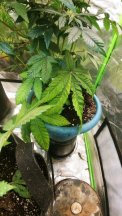
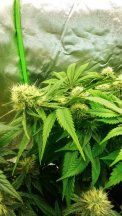
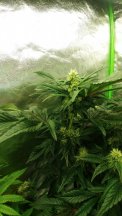
 horticulturelightinggroup.com
horticulturelightinggroup.com
I can't seem to find an actual spec sheet for those boards to see what they'd run at. But yes you could use that driver.
Do you have a link or the spec sheet you could post?
Thanks guys. I only have the info that is in that link that Terpy posted. I see they recommend the 240H-2100, Giving around 47w per board. Looks like the one I have would run them at only 31w per board, but would still work? Is that right?Glad to help put afellow quantum whore!!!! Welcome to the fam, paradise!!QB120 V2 Board Guide
High efficiency boards designed for Horticulture Lighting projects. QB 120 Boards can be powered upto 70 watts. Ideal for use in grow tents or grow area with reflective walls and grow spaces with limited height. No metal heatsink or thermal paste is required .horticulturelightinggroup.com
